Five Fun Rounds
1. Fa, La, La! 2.Hush-you-bye 3. A Certain Young Fellow 4. If You're Happy ;-) 5. Peter Piper
-
Ships in 1 to 2 weeks
Details
Description
SKU: CF.BL1053
1. Fa, La, La! 2.Hush-you-bye 3. A Certain Young Fellow 4. If You're Happy ;-) 5. Peter Piper. Composed by Vicki Tucker Courtney. Fold. Octavo. 8 pages. BriLee Music #BL1053. Published by BriLee Music (CF.BL1053).UPC: 680160911646. 6.875 x 10.5 inches. Key: C minor. English. Traditional.
Rounds develop ensemble, tone and unified vowels through the introduction of the unison melody. These original rounds utilize traditional texts for convenience and ease of learning how to sing in canon. Each round can be amended for variety. Example. Round Number 1, Fa, la, la!, can be performed using solfege syllables on each eighth note, if desired. Feel free to explore the use of other texts (different consonant and vowel sounds) as well as variation of tempo. The goal is to make these work for the teaching/learning needs of the ensemble. Number 2, Hush-you-bye, is self explanatory, as it is a lovely lullaby. Number 3, A Certain Young Fellow, is a round for up to three parts utilizing a hilarious limerick. While I've included piano accompaniment, you can explore singing it a cappella, if you wish, as a unison melody, or two-part round, or add a third part-round. Tailor this one to meet the needs of your ensemble. Number 4, If Youre Happy, is a traditional text suitable for adding movements each time, if desired. Have fun. Lastly, Number 5, Peter Piper, is the traditional tongue twister set in a swing rhythm. I hope you enjoy and explore the many ways to have fun singing rounds!.
Rounds develop ensemble, tone and unified vowels through the introduction of the unison melody.A These original rounds utilize traditional texts for convenience and ease of learning how to sing in canon. Each round can be amended for variety. Example. Round Number 1, Fa, la, la!, can be performed using solfege syllables on each eighth note, if desired. Feel free to explore the use of other texts (different consonant and vowel sounds) as well as variation of tempo. The goal is to make these work for the teaching/learning needs of the ensemble. Number 2, Hush-you-bye, isA self explanatory, as it is a lovely lullaby. Number 3, A Certain Young Fellow, is a round for up to three parts utilizing a hilarious limerick. While I've included piano accompaniment, you can explore singing it a cappella, if you wish, as a unison melody, or two-part round, or add a third part-round. Tailor this one to meet the needs of your ensemble. Number 4, If Youare Happy, is a traditional text suitable for adding movements each time, if desired. Have fun. Lastly,A Number 5, Peter Piper, is the traditional tongue twister set in a swing rhythm. I hope you enjoy and explore the many ways to have fun singing rounds!.
Rounds develop ensemble, tone and unified vowels through the introduction of the unison melody.A These original rounds utilize traditional texts for convenience and ease of learning how to sing in canon. Each round can be amended for variety. Example. Round Number 1, "Fa, la, la!," can be performed using solfege syllables on each eighth note, if desired. Feel free to explore the use of other texts (different consonant and vowel sounds) as well as variation of tempo. The goal is to make these "work" for the teaching/learning needs of the ensemble. Number 2, "Hush-you-bye," isA self explanatory, as it is a lovely lullaby. Number 3, "A Certain Young Fellow," is a round for up to three parts utilizing a hilarious limerick. While I've included piano accompaniment, you can explore singing it a cappella, if you wish, as a unison melody, or two-part round, or add a third part-round. Tailor this one to meet the needs of your ensemble. Number 4, "If Youare Happy," is a traditional text suitable for adding movements each time, if desired. Have fun. Lastly,A Number 5, "Peter Piper," is the traditional tongue twister set in a swing rhythm. I hope you enjoy and explore the many ways to have fun singing rounds!.
Rounds develop ensemble, tone and unified vowels through the introduction of the unison melody. These original rounds utilize traditional texts for convenience and ease of learning how to sing in canon. Each round can be amended for variety. Example. Round Number 1, "Fa, la, la!," can be performed using solfege syllables on each eighth note, if desired. Feel free to explore the use of other texts (different consonant and vowel sounds) as well as variation of tempo. The goal is to make these "work" for the teaching/learning needs of the ensemble. Number 2, "Hush-you-bye," is self explanatory, as it is a lovely lullaby. Number 3, "A Certain Young Fellow," is a round for up to three parts utilizing a hilarious limerick. While I've included piano accompaniment, you can explore singing it a cappella, if you wish, as a unison melody, or two-part round, or add a third part-round. Tailor this one to meet the needs of your ensemble. Number 4, "If You're Happy," is a traditional text suitable for adding movements each time, if desired. Have fun. Lastly, Number 5, "Peter Piper," is the traditional tongue twister set in a swing rhythm. I hope you enjoy and explore the many ways to have fun singing rounds!.
Rounds develop ensemble, tone and unified vowels through the introduction of the unison melody. These original rounds utilize traditional texts for convenience and ease of learning how to sing in canon. Each round can be amended for variety. Example. Round Number 1, "Fa, la, la!," can be performed using solfege syllables on each eighth note, if desired. Feel free to explore the use of other texts (different consonant and vowel sounds) as well as variation of tempo. The goal is to make these "work" for the teaching/learning needs of the ensemble. Number 2, "Hush-you-bye," is self explanatory, as it is a lovely lullaby. Number 3, "A Certain Young Fellow," is a round for up to three parts utilizing a hilarious limerick. While I've included piano accompaniment, you can explore singing it a cappella, if you wish, as a unison melody, or two-part round, or add a third part-round. Tailor this one to meet the needs of your ensemble. Number 4, "If You're Happy," is a traditional text suitable for adding movements each time, if desired. Have fun. Lastly, Number 5, "Peter Piper," is the traditional tongue twister set in a swing rhythm. I hope you enjoy and explore the many ways to have fun singing rounds!.
Rounds develop ensemble, tone and unified vowels through the introduction of the unison melody. These original rounds utilize traditional texts for convenience and ease of learning how to sing in canon. Each round can be amended for variety.Example. Round Number 1, "Fa, la, la!," can be performed using solfege syllables on each eighth note, if desired. Feel free to explore the use of other texts (different consonant and vowel sounds) as well as variation of tempo. The goal is to make these "work" for the teaching/learning needs of the ensemble.Number 2, "Hush-you-bye," is self explanatory, as it is a lovely lullaby.Number 3, "A Certain Young Fellow," is a round for up to three parts utilizing a hilarious limerick. While I've included piano accompaniment, you can explore singing it a cappella, if you wish, as a unison melody, or two-part round, or add a third part-round. Tailor this one to meet the needs of your ensemble.Number 4, "If You’re Happy," is a traditional text suitable for adding movements each time, if desired. Have fun.Lastly, Number 5, "Peter Piper," is the traditional tongue twister set in a swing rhythm.I hope you enjoy and explore the many ways to have fun singing rounds!
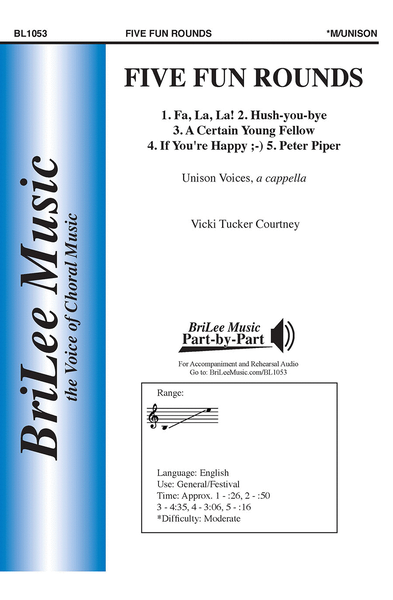
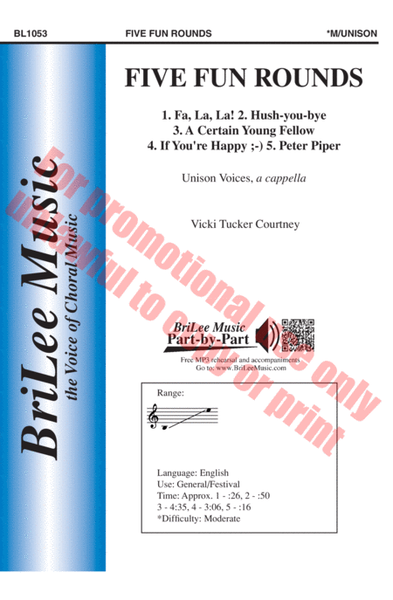
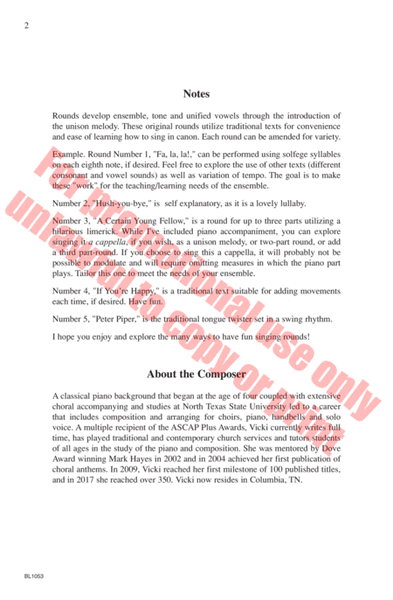
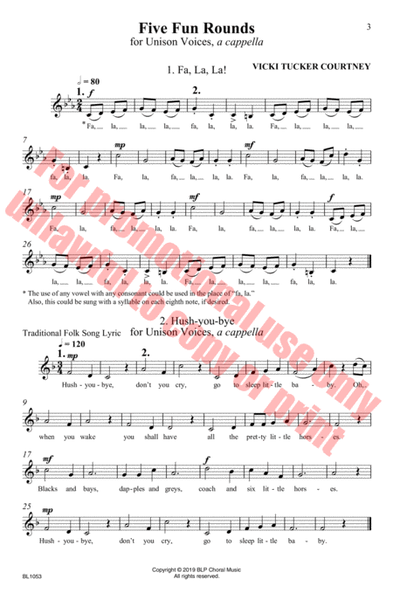
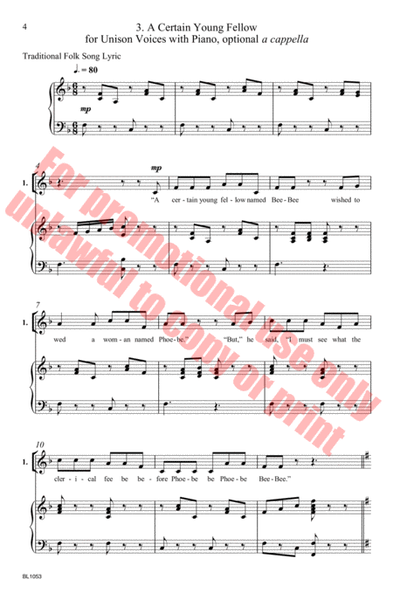

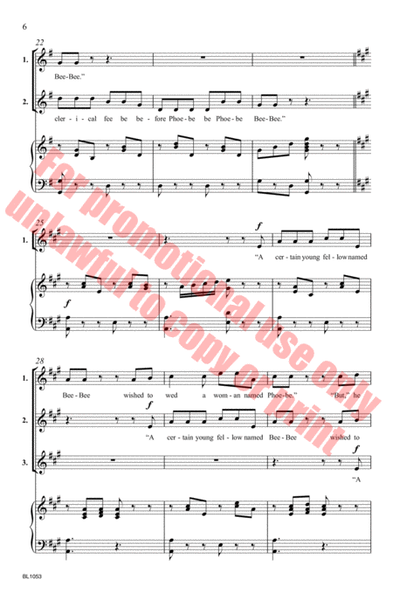
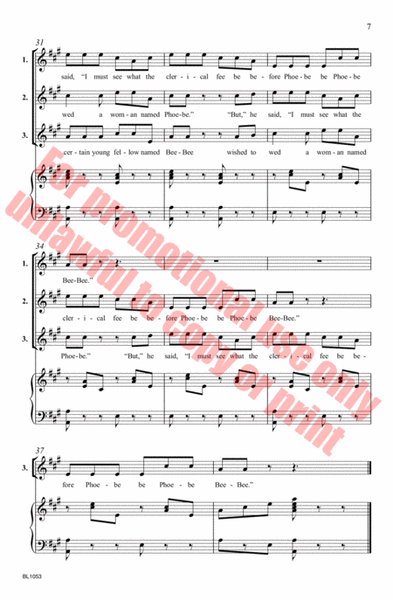
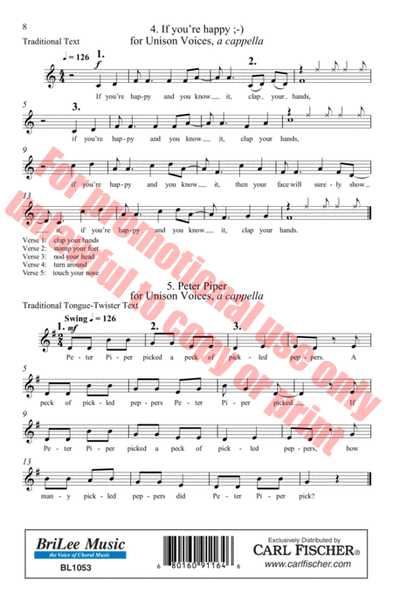
 Share
Share